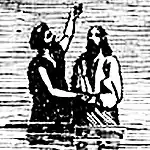General Association of Regular Baptist Churches
The General Association of Regular Baptist Churches (GARBC), established in 1932 is one of several Baptist groups in North America retaining the name "Regular Baptist".
| Part of a series on |
| Baptists |
|---|
 |
History
The impact of modernism on the Northern Baptist Convention (now called the American Baptist Churches in the USA) led to the eventual withdrawal of a number of conservative and fundamentalist churches. The Baptist Bible Union (BBU) of 1923 was the forerunner to the GARBC. The final meeting of the BBU in 1932 in Chicago was the first meeting of the GARBC.
Philosophy
The association endorses a fourfold mission:
- Champion Biblical Truth
- Impact the World for Christ
- Perpetuate a Baptist Heritage
- Advance the Association Churches
Organization
The GARBC follows a "fellowship" model rather than a denominational model. Each member church is free to act independently in all matters. The home office of the GARBC holds no controlling power over member churches. The purpose of the association is for fellowship between churches of like faith and practice.
The association's home office is located at 3715 N. Ventura Dr., Arlington Heights, Illinois. On this site, Regular Baptist Press publishes church education curriculum and the association's bimonthly magazine, the Baptist Bulletin.
Rev. Mike Hess[1] presently serves as the association's National Representative. In 2018, the GARBC had over 1,200 member churches.
According to the 2008 Yearbook of American & Canadian Churches, the GARBC reported having 1,383 churches and 132,900 members in 2005.[2] Membership is concentrated in the Midwest. The states with the highest membership rates are Indiana, Iowa, Michigan, and Ohio.[3]
See also
Sources
- Baptists Around the World, by Albert W. Wardin, Jr.
- Dictionary of Baptists in America, Bill J. Leonard, editor
References
- http://www.garbc.org/about-us/directory-of-ministries/
- Data from the National Council of Churches' 2008 Yearbook of American and Canadian Churches
- Data from the 2000 Religious Congregations and Membership Study